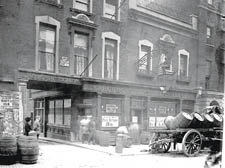|
|
 |
| |

Marchmont Street, pictured in 1903 |
Take a walk down memory street
KENNETH Williams, who lived above his father’s hairdressing shop at number 57 until he was 30, was just one of the many eminent people that have lived on Marchmont Street in Bloomsbury.
Virginia Woolf wrote in her diary in 1924 that she thought the street resembled Paris and asked: “Why do I love it so much?”
The cheesemongers, fishmongers and bootmakers are long since gone, replaced by conglomerates William Hill, Safeway and Snappy Snaps, but Marchmont Street still has its history.
Images of the street, then and now, appeared in house number order at Mary Ward Settlement on Tavistock Place last month. The Story of Marchmont Street exhibition has found a new home in Holborn Library, although too cramped to be exhibited as the walk down memory lane originally intended.
Funded by the Awards For All lottery fund, images taken in 1903, 1930 and this year as well as newspaper cuttings and maps including Charles Booth’s poverty map, give an historical insight into the changing face of London.
The fields and nearby mish-mash of streets surrounding philanthropist Thomas Coram’s Foundling Hospital for abandoned children, now the site of the Brunswick Centre, was transformed into a neat grid of shopping and residential streets by the Foundling Estate in the early 19th century.
Ernest Milner’s prolific portfolio of photos, taken in 1903 to investigate claims of subsidence by private owners for an insurance company, contrast drastically from images of the present day taken by the chair of the Marchmont Street Association, Ricci De Freitas.
The 1930s collection, provided by Marchmont Properties, illuminates the significant yet comparatively slow development in the early part of the 20th century.
There were signs of dining rooms and cafés springing up and the growth of Savile Row but nothing as sweeping as the changes since 1960.
Outside the bootmakers, which traded from 1880 for 70 years at Number 3 two young boys stand still for Milner.
One wears urchin style shin length shorts and a flat cap.
The other stands proud in a three piece suit and top hat.
These ghostly romantic black and whites contrast with the clear colour photography produced on De Freitas’ digital camera.
De Freitas makes no attempt to beautify.
An aerial view of the grid of streets around the Brunswick Centre shows how many streets were demolished to make way for the modern mixed use complex.
The windows of the Georgian building at number 96, which has served as a chemist and a post office, are still blocked in from before the window tax was abolished in 1851.
The curators take this opportunity to point out that although the building was restored in 2006 it remains unlisted.
The exhibition places plenty of emphasis on the ornamental corbels that adorn the street.
Ricci De Freitas hopes the exhibition will draw shoppers to the area and encourage the present leaseholders and owners to restore the street and renovate their ageing buildings themselves. He said: “We need the owners to restore the buildings. But you can’t force people to do this. You have to encourage them.”
SARA NEWMAN
• The Story of Marchmont Street is at Holborn Library until October 23
|
 |
|
 |
|

